This iconic Filipino street food has earned its place as one of the most beloved dishes in Filipino cuisine. Our version elevates the traditional pork barbecue by combining time-honored techniques with precise measurements to create the perfect balance of flavors.
The secret lies in our two-stage marination process and careful basting technique, which results in incredibly tender meat with a gorgeously caramelized exterior. These sweet-savory pork skewers deliver restaurant-quality results right from your home grill.
While it takes time to prepare, the result is absolutely worth the wait – juicy, flavorful pork with sticky-sweet edges that will have everyone reaching for seconds.
Jump to:
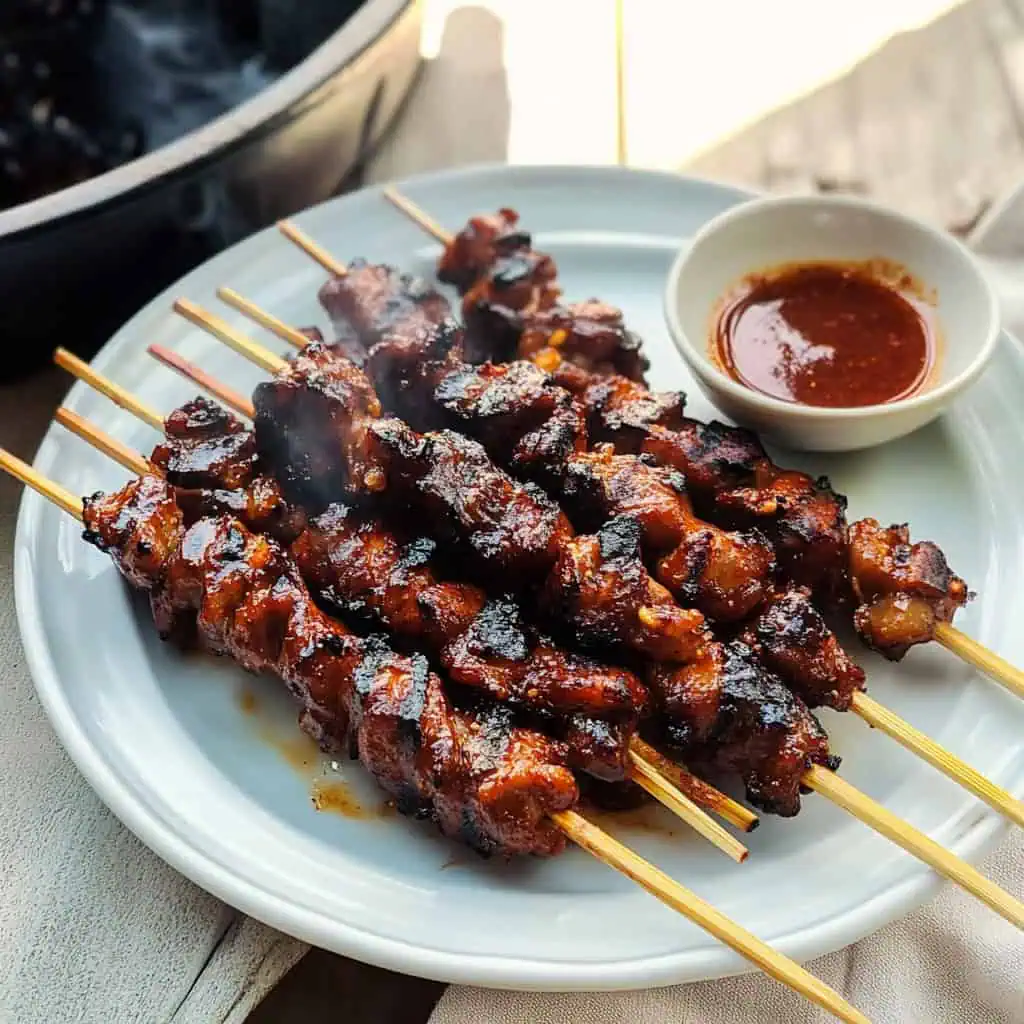
Why You'll Love This Recipe
- Perfect balance of sweet, salty, and spicy flavors (matamis, maalat, at maanghang)
- Tender, juicy meat with caramelized edges
- Make-ahead friendly for parties and gatherings
- Authentic Filipino taste with modern cooking precision
- Restaurant-quality results at home
Ingredients
This recipe uses a carefully selected blend of ingredients that each serve a specific purpose. The 7-up tenderizes the meat with its natural acids while adding sweetness. Soy sauce provides umami depth and salt, while vinegar balances with tanginess and helps preserve the meat.
Brown sugar creates the signature caramelization and sticky texture. The combination of banana ketchup and oyster sauce in the basting mixture adds complex sweetness and richness that can't be achieved with either ingredient alone.
Thai chilies provide just enough heat to enhance flavors without overwhelming the palate, while garlic infuses the meat with its aromatic compounds during marination.
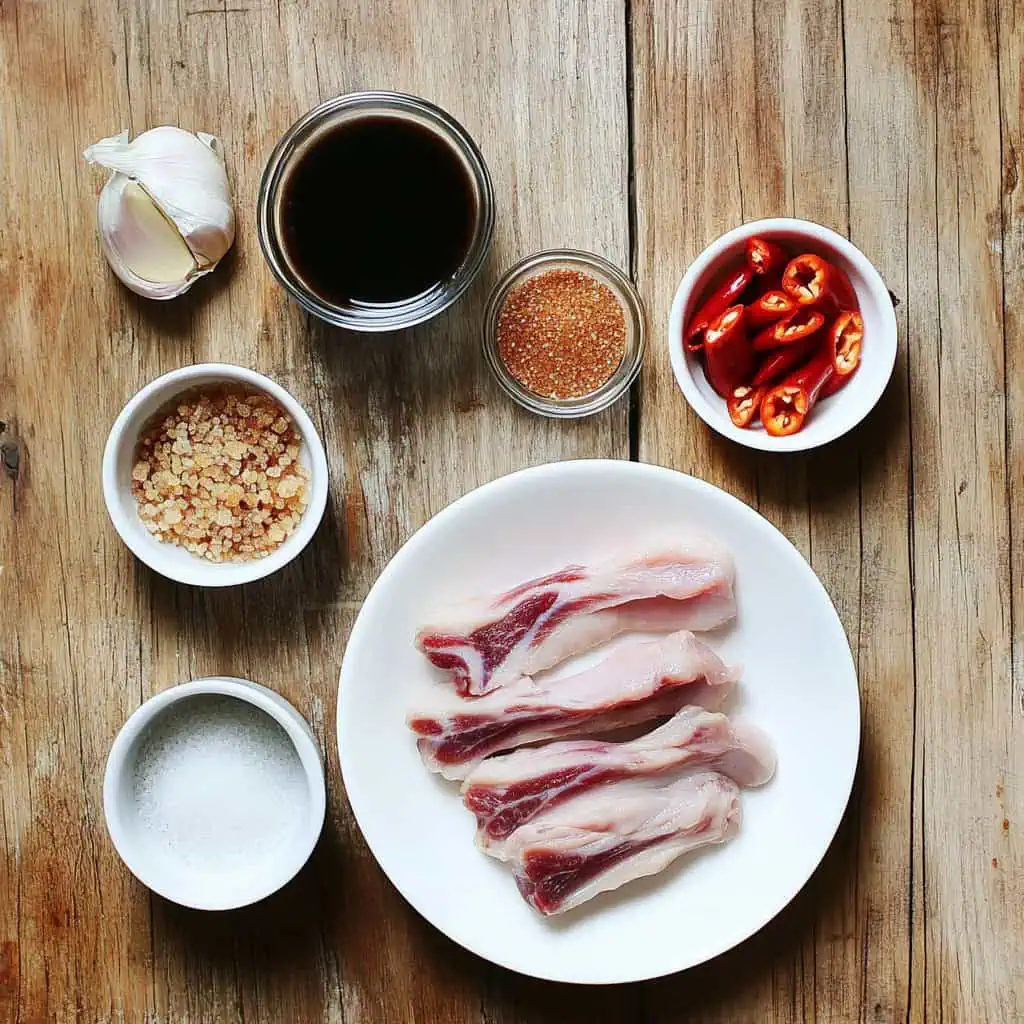
- 6 pounds pork butt, sliced to 1-inch wide and ¼-inch thick
- Pro tip: Ask your butcher for "pork cut for BBQ" for perfect slices
For the Marinade:
- 3 cups 7-up or Sprite
- 2 cups soy sauce
- 2 cups vinegar
- 2 cups oyster sauce
- 3 cups brown sugar
- 1 tablespoon ground black pepper
- 1 cup minced garlic
- 10 Thai chili peppers, minced
For the Basting Sauce:
- 2 cups banana ketchup
- ½ cup sesame oil
- 1 cup oyster sauce
Equipment
- Charcoal grill - For authentic smoky flavor that creates the signature taste
- Meat slicer or sharp knife - Essential for achieving precise 1-inch wide, ¼-inch thick cuts
- Large glass or non-reactive bowl - Prevents unwanted reactions with the acidic marinade
- Bamboo skewers - Traditional choice for threading meat; provides authentic presentation
- Basting brush - Helps apply sauce evenly for consistent caramelization
- Meat thermometer - Ensures food safety by verifying proper internal temperature
- Long-handled tongs - Keeps hands safe from heat while allowing precision turning

How To Make
- Soak bamboo skewers in water for 30 minutes to prevent burning during grilling. While waiting, make your marinade by mixing 7-up, soy sauce, vinegar, 2 cups oyster sauce, brown sugar, minced garlic, black pepper, and minced Thai chilies in a large bowl. Stir until sugar completely dissolves.
- Slice your pork butt into uniform pieces, about 1-inch wide and ¼-inch thick. You can ask your butcher to do this for you. Rinse the meat and pat dry with paper towels.
- Put the meat in the marinade, making sure all pieces are well-coated. Cover and place in the refrigerator for 4-8 hours or overnight.
- When ready to cook, start your charcoal grill. Wait until the charcoal is covered with gray ash and glowing red underneath (about 350-400°F/175-200°C).
- While the grill heats, make your basting sauce. Mix banana ketchup, sesame oil, and 1 cup oyster sauce in a bowl. Set aside.
- Take the meat from the marinade and thread 2-3 slices onto each soaked skewer, leaving small gaps between pieces. Discard the used marinade.
- Place skewers on the hot grill. Cook for 2-3 minutes on each side before applying any basting sauce. Once the meat starts changing color, brush on your basting sauce.
- Keep grilling and basting, turning the skewers every few minutes until cooked through, about 15-20 minutes total. If flames flare up, move the skewers to a cooler spot on the grill.
- For the dipping sauce, mix vinegar, minced garlic, chopped onions, chopped Thai chilies, pepper, and salt in a small bowl.
- Let the barbecue rest for 2-3 minutes after grilling. Serve hot with the spiced vinegar dip, steamed rice, and pickled papaya (atchara).
Note: For food safety, the pork should reach an internal temperature of 145°F (63°C).

Tips from Lola's Kitchen
- Wait for proper charcoal temperature - Charcoal should be covered with white ash before grilling begins
- Position skewers strategically - Keep them from directly dripping onto coals to prevent flare-ups and burning
- Double marinade for extra flavor - For an extra flavor boost, reserve some fresh marinade for a second coating halfway through marination time
- Turn with precision - Rotate skewers evenly and consistently for balanced cooking and caramelization
- Thread meat loosely - Leave small gaps between meat pieces to ensure even cooking throughout
- Pat meat dry before grilling - Remove excess marinade to reduce flare-ups and promote better caramelization
- Rest before serving - Allow the meat to rest 2-3 minutes after grilling to retain juices
Substitutions
- 7-up/Sprite: Pineapple juice mixed with a little sugar or any lemon-lime soda
- Banana ketchup: Tomato ketchup mixed with 2 tablespoons brown sugar and a dash of allspice
- Oyster sauce: Hoisin sauce or thick soy sauce mixed with a pinch of sugar
- Thai chilies: Red pepper flakes, jalapeños, or serrano peppers
- Pork butt: Pork shoulder or pork belly (adjust cooking time accordingly)
- Brown sugar: White sugar with a splash of molasses or coconut sugar
- Sesame oil: Vegetable oil with 1 tablespoon toasted sesame seeds
Troubleshooting
Problem: Barbecue is burning too quickly
- Solution: Raise the grilling grate higher from the heat source
- Solution: Reduce the amount of coals or spread them out more thinly
- Solution: Decrease the amount of sugar in the marinade
- Solution: Grill over indirect heat (coals on one side, meat on the other)
Problem: Meat is too tough
- Solution: Slice meat thinner, aiming for ¼-inch thickness
- Solution: Ensure 7-up is included in marinade as it acts as a natural tenderizer
- Solution: Don't overcook; use a meat thermometer to check doneness
- Solution: Avoid marinating longer than 24 hours as acids can toughen meat
Problem: Skewers keep catching fire
- Solution: Soak bamboo skewers for at least 30 minutes, or even overnight
- Solution: Wrap exposed parts of skewers with aluminum foil
- Solution: Consider using metal skewers as an alternative
Problem: Marinade not flavorful enough
- Solution: Increase marination time to at least 8 hours
- Solution: Pierce meat with a fork before marinating to allow better penetration
- Solution: Add more aromatics like ginger or lemongrass to boost flavor
Storage & Reheating
Storage:
- Store cooked barbecue in an airtight container in the refrigerator for up to 3 days
- For longer storage, wrap individual portions in aluminum foil, place in freezer bags, and freeze for up to 3 months
Reheating:
- In the oven: Wrap in foil and heat at 350°F (175°C) for 10-12 minutes
- On the grill: 2-3 minutes per side over medium heat
- In the microwave: 1-2 minutes on medium power, though this method may make the meat slightly tough
For frozen barbecue:
- Thaw overnight in the refrigerator before reheating
- For quick thawing, place sealed packages in cold water, changing water every 30 minutes

FAQ
Why is 7-up or Sprite used in the marinade?
The soda contains citric acid which helps tenderize the meat, while the sugar contributes to caramelization. It also adds subtle sweetness and helps balance the flavors.
Can I make this indoors?
Yes, you can use a stovetop grill pan or oven broiler. Place skewers on a foil-lined baking sheet and broil 6 inches from heat, turning every 3-4 minutes. Note that the authentic smoky flavor will be different.
How do I prevent flare-ups during grilling?
Make sure to pat the meat dry before placing it on the grill. Position skewers so they're not directly over the hottest part of the coals, and keep a spray bottle of water handy.
Can I reuse the marinade for basting?
Only if you boil it for at least 10 minutes to kill bacteria. For food safety and best flavor, it's recommended to make a fresh basting sauce instead.
What's the best cut of pork to use?
Pork butt (shoulder) is ideal as it has the right fat-to-meat ratio. It stays tender during grilling and absorbs flavor well.
Can I prepare the skewers ahead of time?
Yes, you can thread the marinated meat onto skewers up to 24 hours before cooking. Keep them covered in the refrigerator until ready to grill.
What sides pair well with Filipino pork barbecue?
Traditional accompaniments include steamed rice, pickled green papaya (atchara), spiced vinegar dipping sauce, and grilled vegetables. It also pairs wonderfully with pancit (Filipino noodles) or ensaladang talong (eggplant salad).
Related
Looking for other recipes like this? Try these:
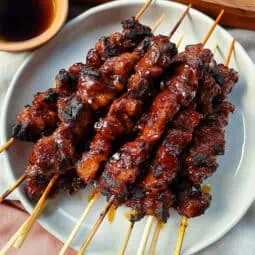
Filipino Pork Barbecue (Inihaw na Baboy)
Equipment
- Charcoal grill (ihawan) For authentic smoky flavor
- Meat Slicer or Sharp Knife (Matulis na Kutsilyo) For precise 1-inch wide, ¼-inch thick cuts
- Large Glass or Non-reactive Bowl (Malaking Mangkok) For marinating
- Bamboo Skewers (Barbecue Stick) For threading meat
- Basting brush For applying sauce
- Meat thermometer For ensuring proper cooking temperature
- Long-handled Tongs (Sipit) For safe grilling
Ingredients
For the Meat:
- 6 pounds pork butt kasim, sliced to 1-inch wide and ¼-inch thick
- Pro tip: Ask your butcher for "pang-BBQ na hiwa" for perfect cuts
For the Marinade:
- 3 cups 7-up or Sprite
- 2 cups soy sauce toyo
- 2 cups vinegar suka
- 2 cups oyster sauce sawsawang talaba
- 3 cups brown sugar asukal na pula
- 1 tablespoon ground black pepper dinurog na paminta
- 1 cup minced garlic bawang
- 10 Thai chili peppers/siling labuyo minced
For the Basting Sauce (Pang-pahid):
- 2 cups banana ketchup banana catsup
- ½ cup sesame oil langis ng sesame
- 1 cup oyster sauce
Instructions
- Soak bamboo skewers in water for 30 minutes to prevent burning during grilling. While waiting, make your marinade by mixing 7-up, soy sauce, vinegar, 2 cups oyster sauce, brown sugar, minced garlic, black pepper, and minced Thai chilies in a large bowl. Stir until sugar completely dissolves.
- Slice your pork butt into uniform pieces, about 1-inch wide and ¼-inch thick (pang-BBQ na hiwa). You can ask your butcher to do this for you. Rinse the meat and pat dry with paper towels.
- Put the meat in the marinade, making sure all pieces are well-coated. Cover and place in the refrigerator for 4-8 hours or overnight.
- When ready to cook, start your charcoal grill. Wait until the charcoal is covered with gray ash and glowing red underneath (about 350-400°F/175-200°C).
- While the grill heats, make your basting sauce. Mix banana ketchup, sesame oil, and 1 cup oyster sauce in a bowl. Set aside.
- Take the meat from the marinade and thread 2-3 slices onto each soaked skewer, leaving small gaps between pieces. Throw away the used marinade.
- Place skewers on the hot grill. Cook for 2-3 minutes on each side before applying any basting sauce. Once the meat starts changing color, brush on your basting sauce.
- Keep grilling and basting, turning the skewers every few minutes until cooked through, about 15-20 minutes total. If flames flare up, move the skewers to a cooler spot on the grill.
- For the dipping sauce, mix vinegar, minced garlic, chopped onions, chopped Thai chilies, pepper, and salt in a small bowl.
- Let the barbecue rest for 2-3 minutes after grilling. Serve hot with the spiced vinegar dip, steamed rice, and pickled papaya (atchara).
- Enjoy your homemade Filipino Pork Barbecue while it's hot and fresh off the grill!
- Note: For food safety, the pork should reach an internal temperature of 145°F (63°C).
Tips from Lola's Kitchen
- "Pag-iinitin ang uling, hintaying maging puti" (Wait for the charcoal to turn white-hot)
- "Para hindi masunog, iwasang may tumutulo sa uling" (Prevent flare-ups by avoiding marinade drips)
- "Kung gusto mong mas malasa, dalawang beses ibabad" (For more flavor, marinate twice)
- "Huwag kalimutang baliktarin ng pantay" (Don't forget to turn evenly)
Nutrition
The Story Behind Filipino Pork Barbeque
In the vibrant streets of the Philippines, where the aroma of grilling meat mingles with the warm tropical air, Filipino Pork Barbecue stands as a testament to the country's rich culinary heritage. This beloved street food, known locally as "inihaw na baboy," has evolved from humble beginnings to become a national treasure that graces both street corners and prestigious celebrations.
The origins of Filipino Pork Barbecue can be traced back to the pre-colonial era, when indigenous cooking methods involved skewering meat on bamboo sticks and cooking over open flames. However, the recipe we know today was significantly influenced by Chinese traders who introduced soy sauce and various marinades to the archipelago. The American colonial period further transformed the dish with the introduction of banana ketchup, a uniquely Filipino creation born during World War II when tomatoes were scarce.
What sets Filipino Pork Barbecue apart from other Asian grilled meats is its distinctive marinade. Unlike its regional counterparts, Filipino barbecue embraces a complex harmony of sweet, salty, and tangy flavors. The secret lies in the unexpected addition of lemon-lime soda, a technique that emerged in the 1960s when street vendors discovered that carbonated beverages not only tenderized the meat but also added a subtle sweetness that caramelizes beautifully on the grill.
Today, you'll find these succulent skewers being grilled on almost every street corner in the Philippines, particularly during the late afternoon hours when workers head home and students finish their classes. The sight of street vendors fanning their improvised grills, the sound of meat sizzling over hot coals, and the rhythmic motion of basting the skewers with marinade have become iconic scenes in Filipino daily life.
The popularity of Filipino Pork Barbecue has transcended its street food origins to become a staple at family gatherings, fiestas, and even high-end restaurants. From simple neighborhood gatherings to elaborate beach parties, no Filipino celebration feels complete without these flavorful skewers. The dish has also gained international recognition, with Filipino communities worldwide sharing this beloved recipe and adapting it to local tastes while maintaining its essential character.
What makes this dish particularly special is its role in Filipino social culture. The preparation often becomes a communal activity, with family members taking turns marinating, skewering, and grilling the meat. This shared experience, known as "bayanihan" spirit, transforms a simple cooking process into a celebration of Filipino hospitality and togetherness.
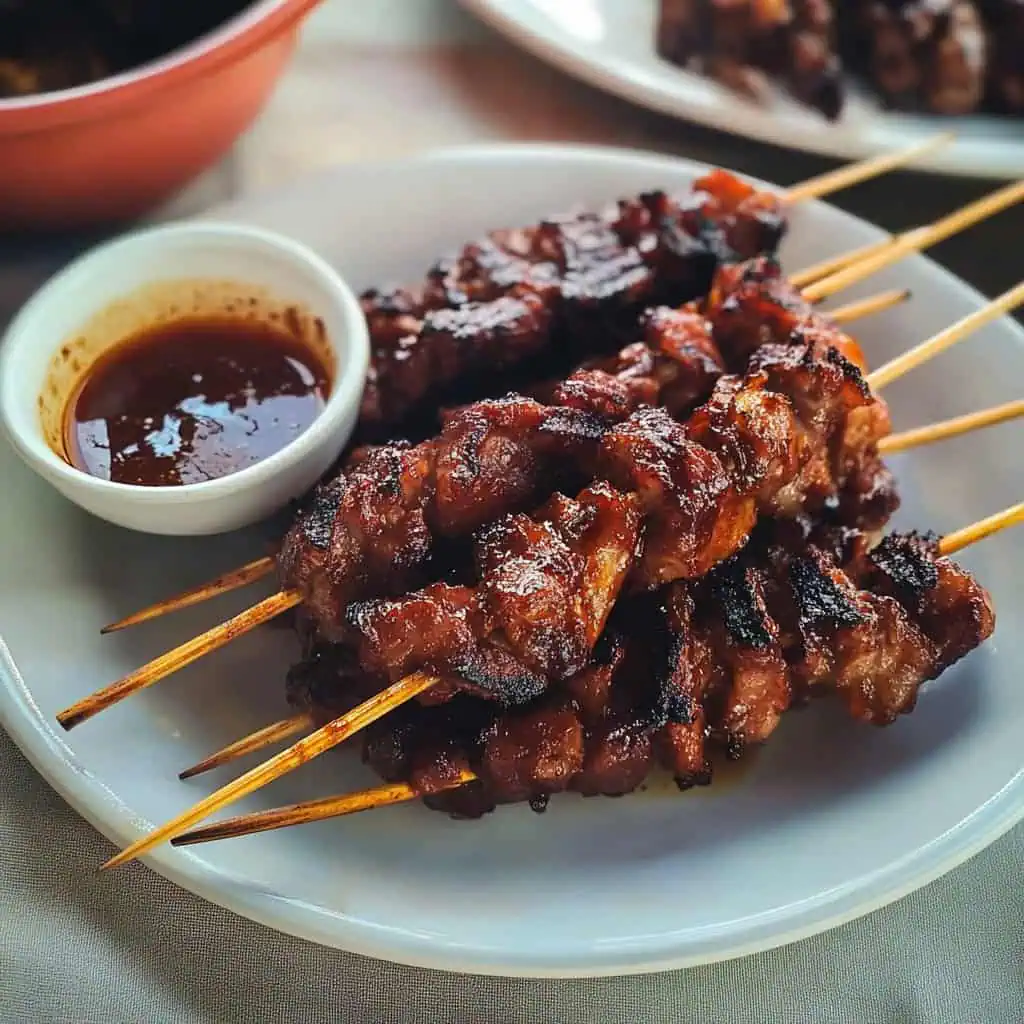






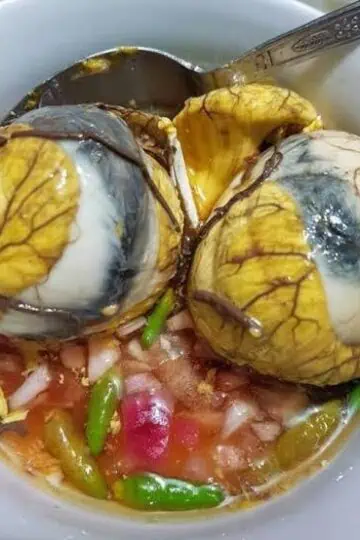
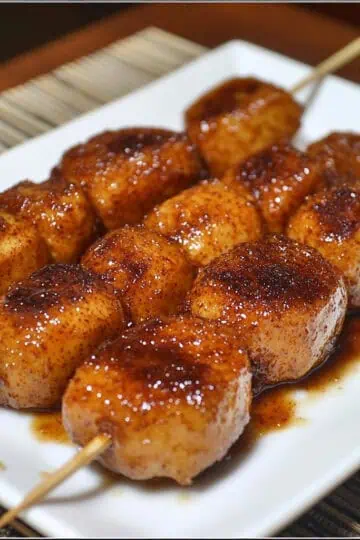

Comments
No Comments